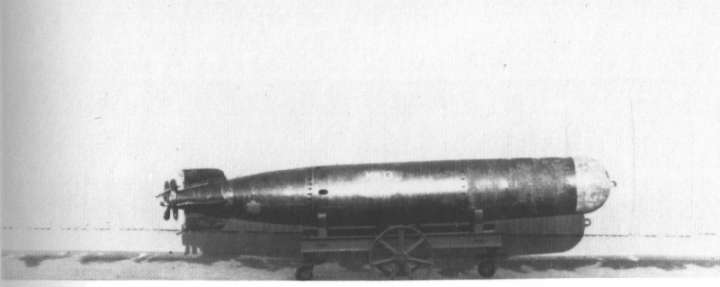

The Mk13 was to a large part responsible for the disaster that befell the U.S. torpedo bombers at Midway. It was the air-dropped part of the Mk-13/-14/-15 torpedo family, and shared many of the defects of that family, plus having some of its own.
It was
begun in the 1920s but design progress was slow and interrupted, and it
took its time to enter service with the fleet. One of the reasons was that
in the early 1930s, the torpedo-bomber had come to be doubted as a useful
weapon in the fleet, another the heavy weight of the Mk13. But by the mid-1930s,
design continued, and by 1938, the weapon could be fielded.
Its primary deficit was
the requirements it forced upon the launching plane for a successful drop
- 110 knots speed in fifty feet height. It was a difficult requirement
to fulfill under good conditions but in combat, it meant certain death.
The major other defect was a tendency to run deep if it did at all commence
running all right, which did make a successful attack all the more dependent
on luck.
Its performance, accordingly was poor in the first months of 1942. Although the Shoho was sunk thanks to the Mk13, the attacks on her were in effect training runs without even minor interference. At Midway, over 90% of the attacking Devastator, Marauder and Avenger torpedo planes were shot down over the IJN carriers, without a single hit scored from about 60 torpedos carried to the target.
As time
went by, however, the torpedo was significantly improved in all respects,
and by the February 1944 raid on Truk, it could be safely dropped from
1000ft at high speed. By war's end, 410 knots and 2400 ft were practicable.
The Mk-13 was also used
in PT-Boats later in the war, as they could be dropped over the side instead
of requiring a heavy torpedo-tube, as the Mk15 did. This saved considerable
weight that could be used for the equally important gun, rocket and grenade
armament.
Post-war
reviews showed that there had been 161 hits scored on battleships and carriers,
56 on destroyers, 182 on merchant ships, for a total of 40% hits from 1287
attacks.
The Japanese, who captured
several of these torpedoes, believed them too short for good, stable underwater
trajectory. Their own contemporary torpedo carried less explosive but was
faster and could be dropped at a higher speed. The Mk-13 charge was not
improved during the war, but the Japanese torpedo's was, making it a better
torpedo if it could be dropped, but the Mk-13 of later years made the platform
carrying it more survivable.
|
|
Year of Construction:
1930
Bore: 569mm Weight: 1005 kg / 2216 lbs Length: 4089 mm / 13ft 5in Max. Range: 5760 m / 6300 yards at 33.5kts Explosive Charge: 262 kg / 600 lbs Torpex |